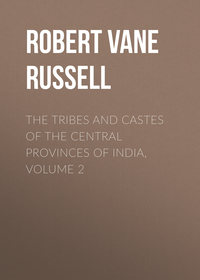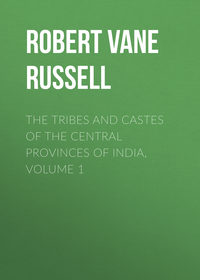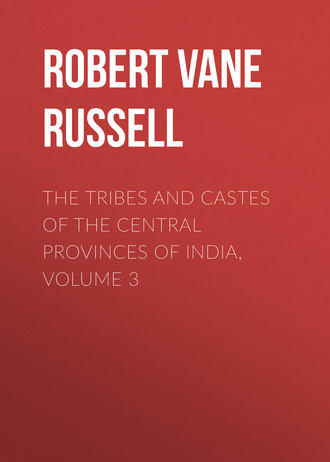 полная версия
полная версияThe Tribes and Castes of the Central Provinces of India, Volume 3
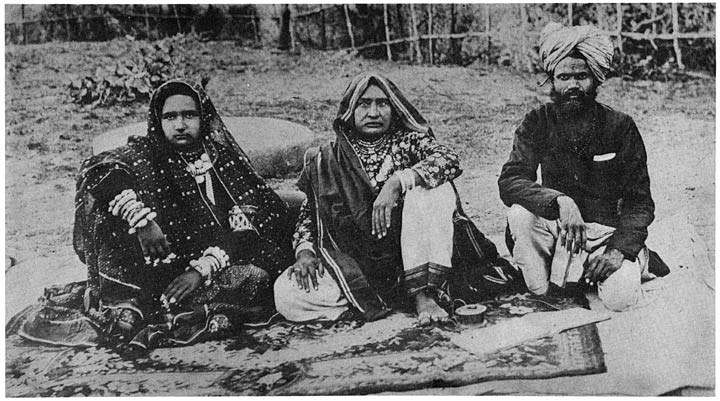
Gūjar village proprietress and her land agent
2. The Gūjars and the Khazars
Sir J. Campbell identified the Gūjars with the Khazar tribe of Central Asia:119 “What is known of the early history of the Gujaras in India points to their arrival during the last quarter of the fifth or the first quarter of the sixth century (A.D. 470–520). That is the Gujaras seem to have formed part of the great horde of which the Juān-Juān or Avārs, and the Ephthalites, Yetas or White Hūnas were leading elements. The question remains: How far does the arrival of the Gujara in India, during the early sixth century, agree with what is known of the history of the Khazar? The name Khazar appears under the following forms: Among Chinese as Kosa, among Russians as Khwalisses, among Byzantines as Chozars or Chazars, among Armenians as Khazirs and among Arabs as Khozar. Other variations come closer to Gujara. These are Gazar, the form Kazar takes to the north of the sea of Asof; Ghysar, the name for Khazars who have become Jews; and Ghusar, the form of Khazar in use among the Lesghians of the Caucasus. Howarth and the writer in the Encyclopædia Britannica follow Klaproth in holding that the Khazars are the same as the White Hūnas....
“Admitting that the Khazar and White Hūna are one, it must also be the case that the Khazars included two distinct elements, a fair or Ak-Khazar, the Akatziroi or Khazaroi of Byzantine historians, and a dark or Kāra Khazar. The Kāra Khazar was short, ugly and as black as an Indian. He was the Ughrian nomad of the steppes, who formed the rank and file of the army. The White Khazar or White Hūna was fair-skinned, black-haired and beautiful, their women (in the ninth and tenth centuries) being sought after in the bazārs of Bāghdād and Byzantium. According to Klaproth, a view adopted by the writer in the Encyclopædia Britannica, the White Khazar represented the white race which, since before Christ has been settled round the Caspian. As White Hūnas, Ephthalites,120 White Ughrians and White Bulgars, this white race were the carriers between Europe and East Asia; they were also the bearers of the brunt of the Tartar inroads. A trace both of the beautiful and coarse clans seems to survive in the complimentary Mārwār proverb, ‘Handsome as a Hūna,’ and in the abusive Gujarāt proverb, ‘Yellow and short as a Hūna’s beard.’ Under its Hindu form Gurjara, Khazar appears to have become the name by which the great bulk of the sixth-century horde was known.” Sir J. Campbell was of opinion that the Sesodia or Gahlot Rājpūts, the most illustrious of all the clans, were of Gūjar stock, as well as the Parihār, Chauhān, and Chalukya or Solankī; these last were three of the Agnikula clans or those created from the firepit,121 and a Solankī dynasty ruled in Gujarāt. He also considered the Nāgar Brāhmans of Gujarāt to be derived from the Gūjars and considerable sections of the Ahīr and Kunbi castes. The Badgūjar (great Gūjar) clan of Rājpūts is no doubt also an aristocratic branch of the caste. In Ajmere it is said that though all Gūjars are not Rājpūts, no Rājpūt becomes a hero unless he is suckled by a Gūjar woman. Gūjarika dudh, nāhari ka dudh; or ‘Gūjar’s milk is tiger’s milk.’ A Rājpūt who has not been suckled by a Gūjar woman is a gidar or jackal.122
3. Predatory character of the Gūjars in northern India
The fact of the White Huns being tall and of fine features, in contrast to the horde which invaded Europe under Attila, accounts for these characteristics being found among the highest Rājpūt clans, who, as has been seen, are probably derived from them. The Gūjar caste generally is now, however, no doubt of mixed and impure blood. They were distinguished in the past as vagrant and predatory marauders, and must have assimilated various foreign elements. Mr. Crooke writes of them:123 “The Gūjars as a tribe have always been noted for their turbulence and habit of cattle-stealing. Bābar in his Memoirs describes how the commander of the rearguard captured a few Gūjar ruffians who followed the camp, decapitated them and sent their heads to the Emperor. The Gūjars of Pāli and Pāhal became exceedingly audacious while Sher Shāh was fortifying Delhi, and he marched to the hills and expelled them so that not a vestige of their habitations was left. Jahāngīr remarks that the Gūjars live chiefly on milk and curds and seldom cultivate land; and Bābar says: ‘Every time I entered Hindustān the Jāts and Gūjars have regularly poured down in prodigious numbers from the hills and wilds to carry off oxen and buffaloes. These were the wretches that really inflicted the chief hardships and were guilty of the chief oppression in the country.’ They maintained their old reputation in the Mutiny when they perpetrated numerous outrages and seriously impeded the operations of the British Army before Delhi.” In northern India the Gūjars are a pastoral caste. The saying about them is—
Ahīr, Gadaria, Gūjar,E tinon tâken ujar,or, ‘The Ahīr, Gadaria and Gūjar want waste land’; that is for grazing their flocks. In Kāngra the Gūjars generally keep buffaloes. Here they are described as “A fine, manly race with peculiar and handsome features. They are mild and inoffensive in manner, and in these hills are not distinguished by the bad pre-eminence which attaches to their race in the plains.”124 Sir D. Ibbetson had a very unfavourable opinion of the Gūjars of the plains, of whom he wrote as follows:125 “The Gūjar is a fine stalwart fellow, of precisely the same physical type as the Jāt; and the theory of aboriginal descent which has been propounded is to my mind conclusively negatived by his cast of countenance. He is of the same social standing as the Jāt, or perhaps slightly inferior; but the two eat and drink in common without any scruple, and the proverb says: ‘The Jāt, Gūjar, Ahīr and Gola are all hail fellow well met.’ But he is far inferior in both personal character and repute to the Jāt. He is lazy to a degree, and a wretched cultivator; his women, though not secluded, will not do field-work save of the lightest kind; while his fondness for cattle extends to those of other people. The difference between a Gūjar and a Rājpūt cattle-thief was once explained to me thus by a Jāt: ‘The Rājpūt will steal your buffalo. But he will not send his old father to say he knows where it is and will get it back for Rs. 20, and then keep the Rs. 20 and the buffalo too. The Gūjar will.’”
4. Subdivisions
The Gūjars of the Central Provinces have, however, entirely given up the predatory habits of their brethren in northern India and have developed into excellent cultivators and respectable law-abiding citizens. In Hoshangābād they have three subcastes, Lekha, Mundle and Jādam. The Mundle or ‘Shaven’ are so called because they take off their turbans when they eat and expose their crowns bare of hair, while the Lekha eat with their turbans on. The Mundle are also known as Rewe, from the Rewa or Nerbudda, near which they reside. The Jādam are probably an offshoot from the cultivating caste of Hoshangābād of that name, Jādam being a corruption of Jādubansi, a tribe of Rājpūts. The Badgūjars, who belong to Nimār, consider themselves the highest, deriving their name from bara or ‘great’ Gūjar. As already seen, there is a Badgūjar clan of Rājpūts. The Nimār Badgūjars, however, were formerly engaged in the somewhat humble calling of clearing cotton of its seeds, and on this account they are also known as Ludhāre, the word lodhna meaning to work the hand-ginning machine (charkhi). It seems possible that the small caste of Lorhas of the Hoshangābād District, whose special avocation is to grow san-hemp, may be derived from these Ludhāre Gūjars. The Kekre or Kanwe subcaste are the lowest and are of illegitimate descent. They are known as Kekre or ‘Crabs,’ but prefer their other name. They will take food from the other subcastes, but these do not return the compliment. Another group in the Sohāgpur Tahsīl of Hoshangābād are the Lilorhia Gūjars. They say that their ancestors were grazing calves when some of them with their herdsmen were stolen by Brahma. Then Krishna created fresh cowherds and the Lilorhias were made from the sweat of his forehead (lilat). Afterwards Brahma restored the original cowherds, who were known as Murelia, because they were the first players on the murli or flute.126 The Badgūjars or highest branch of the clan are descendants of these Murelias. The caste have also a set of exogamous groups, several of which bear the names of Rājpūt clans, while others are called after villages, titles or nicknames or natural objects. A man is not permitted to marry any one belonging either to his own sept or that of his mother or grandmother.
5. Marriage
At a Gūjar wedding four plough-yokes are laid out to form a square under the marriage booth, with a copper pot full of water in the centre. At the auspicious moment the bride’s hand is placed on that of the bridegroom, and the two walk seven times round the pot, the bridegroom leading for the first four rounds and the bride for the last three. Widows are allowed to remarry, and, as girls are rather scarce in the caste, a large price is often paid for the widow to her father or guardian, though this is not willingly admitted. As much as Rs. 3000 is recorded to have been paid. A widow marriage is known as Nātra or Pāt. A woman is forbidden to marry any relative of her first husband. When the marriage of a widow is to take place a fee of Rs. 1–4 must be paid to the village proprietor to obtain his consent. The Gūjars of the Bulandshahr District of the United Provinces furnish, Mr. Crooke says,127 perhaps the only well-established instance of polyandry among the Hindus of the plains. Owing to the scarcity of women in the caste it was customary for the wife of one brother, usually the eldest, to be occasionally at the disposal of other unmarried brothers living in the house. The custom arose owing to the lack of women caused by the prevalence of female infanticide, and now that this has been stopped it is rapidly dying out, while no trace of it is believed to exist in the Central Provinces.
6. Disposal of the dead
The bodies of unmarried persons are buried, and also of those who die of any epidemic disease. Others are cremated. The funeral of an elderly man of good means and family is an occasion for great display. A large feast is given and the Brāhman priests of the caste go about inviting all the Gūjars to attend. Sometimes the number of guests rises to three or four thousand. At the conclusion of the feast one of the hosts claps his hands and all the guests then get up and immediately depart without ceremony or saying farewell. Such an occasion is known as Gūjarwāda, and the Gūjars often spend as much, or more, on a funeral as on a wedding, in the belief that the outlay is of direct benefit to the dead man’s spirit. This idea is inculcated and diligently fostered by the family priests and those Brāhmans who receive gifts for the use of the dead, the greed of these cormorants being insatiable.
7. Religion
The household goddess of the caste is known as Kul Devi, the word kul meaning family. To her a platform is erected inside the house, and she must be worshipped by the members of the family alone, no stranger being present. Offerings of cocoanuts, rice, turmeric and flowers are made to her, but no animal sacrifices. When a son of the family dies unmarried, an image of him, known as Mujia, is made on a piece of silver, copper or brass, and is worshipped on Mondays and Fridays during the month of Māgh (January). On one of these days also a feast is given to the caste. Each member of the caste has a guru or spiritual preceptor, who visits him every second or third year and receives a small present of a cocoanut or a piece of cloth. But he does not seem to perform any duties. The guru may belong to any of the religious mendicant castes. A man who is without a guru is known as Nugra and is looked down on. To meet him in the morning is considered unlucky and portends misfortune. Sir C. Elliot128 characterised the Mundle Gūjars as “A very religious race; they never plough on the new moon nor on the 8th of the month, because it is Krishna’s birthday. Their religious and social head is the Mahant of the Rāmjidās temple at Hoshangābād.” In Nimār many of the Gūjars belong to the Pīrzāda sect, which is a kind of reformed creed, based on a mixture of Hinduism and Islām.
8. Character
The Gūjars wear the dress of northern India and their women usually have skirts (lahenga) and not sāris or body-cloths. Married women have a number of strings of black beads round the neck and widows must change these for red ones. As a rule neither men nor women are tattooed. The men sometimes have their hair long and wear beards and whiskers. The Gūjars are now considered the best cultivators of the Nimār District. They are fond of irrigation and sink unfaced wells to water their land and get a second crop off it. They are generally prosperous and make good landlords. Members of the caste have the custom of lending and borrowing among themselves and not from outsiders, and this no doubt conduces to mutual economy and solvency. Like keen cultivators elsewhere, such as the Panwārs and Kurmis, the Gūjar sets store by having a good house and good cattle. The return from a Mundle Gūjar’s wedding, Captain Forsyth wrote,129 is a sight to be seen. Every Gūjar from far and near has come with his whole family in his best bullock-cart gaily ornamented, and, whatever the road may be, nothing but a smash will prevent a breakneck race homewards at full gallop, cattle which have won in several such races acquiring a much coveted reputation throughout the District.
Gurao
1. Origin of the caste
Gurao.130—A caste of village priests of the temples of Mahādeo in the Marātha Districts. They numbered about 14,000 persons in the Central Provinces and Berār in 1911. The Guraos say that they were formerly Brāhmans and worshippers of Siva, but for some negligence or mistake in his ritual they were cursed by the god and degraded from the status of Brāhmans, though subsequently the god relented and permitted them to worship him and take the offerings made to him.
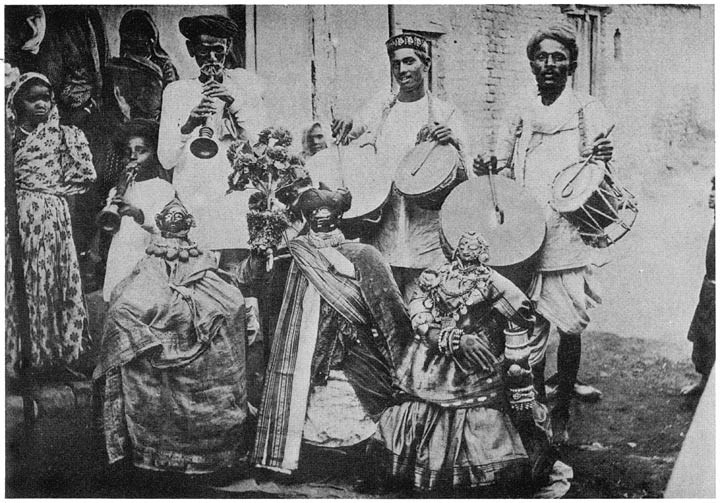
Guraos with figures made at the Holi festival called Gangour
It is related that a certain Brāhman, who was a votary of Siva, had to go on a journey. He left his son behind and strictly enjoined on him to perform the worship of the god at midday. The son had bathed and purified himself for this purpose, when shortly before midday his wife came to him and so importuned him to have conjugal intercourse with her that he was obliged to comply. It was then midday and in his impure condition the son went to the shrine of the god to worship him. But Siva cursed him and said that his descendants should be degraded from the status of Brāhmans, though he afterwards relented so far as to permit of their continuing to act as his priests; and this was the origin of the Guraos. It seems doubtful, however, whether the caste are really of Brāhman origin. They were formerly village priests, and Grant-Duff gives the Gurao as one of the village menials in the Marātha villages. They have the privilege of taking the Naivedya or offerings of cooked food made to the god Mahādeo, which Brāhmans will not accept. They also sell leaf-plates and flowers and bel leaves131 which are offered at the temples of Mahādeo; and on the festival of Shivrātri and during the month of Shrāwan (July) they take round the bel leaves which the cultivators require for their offerings and receive presents in return. In Wardha the Guraos get small gifts of grain from the cultivators at seed-time and harvest. They also act as village musicians and blow the conch-shell, beat the drum and play other musical instruments for the morning and evening worship at the temple. They play on the cymbals and drums at the marriages of Brāhmans and other high castes. In the Bombay Presidency132 some are astrologers and fortune-tellers, and others make the bāsing or coronet of flowers which the bridegroom wears. Sometimes they play on the drum or fiddle for their spiritual followers, the dancing-girls or Kalāvants. When a dancing-girl became pregnant she worshipped the Gurao, and he, in return, placed the missi or tooth-powder made from myrobalans on her teeth. If this was not done before her child was born, a Kalāvantin was put out of caste. In some localities the Guraos will take food from Kunbis. And further, as will be seen subsequently, the caste have no proper gotras or exogamous sections, but in arranging their marriages they simply avoid persons having a common surname. All these considerations point to the fact that the caste is not of Brāhmanical origin but belongs to a lower class of the population. Nevertheless in Wardha they are known as Shaiva Brāhmans and rank above the Kunbis. They may study the Sāma Veda only and not the others, and may repeat the Rudra Gayatri or sacred verse of Siva. Clearly the Brāhmans could not accept the offerings of cooked food made at Siva’s shrine; though the larger temples of this deity have Brāhman priests. It seems uncertain whether Siva or Mahādeo was first a village deity and was subsequently exalted to the position of a member of the supreme Hindu Trinity, or whether the opposite process took place and the Guraos obtained their priestly functions on his worship being popularised. But in any case it would appear that they were originally a class of village priests regarded as the servants of the cultivating community, by whose gifts and offerings they were maintained. Grant-Duff in enumerating the village servants says: “Ninth, the Gurao, who is a Sūdra employed to wash the ornaments and attend the idol in the village temples, and on occasions of feasting to prepare the patraoli or leaves which the Hindus substitute for plates. They are also trumpeters by profession and in this capacity are much employed in Marātha armies.”133
2. Internal structure
The caste has several subdivisions which are principally of a territorial nature, as Warāde from Berār; Jhāde, inhabitants of the forest or rice country; Telanga, of the Telugu country; Dakshne, from the Deccan; Mārwāri, from Mārwār, and so on. Other subcastes are the Ahīr and Jain Guraos, of whom the former are apparently Ahīrs who have adopted the priestly profession, while the Jain Guraos are held in Bombay to be the descendants of Jain temple servants who entered the caste when their own deities were thrown out and their shrines annexed by the votaries of Siva.134 In Bombay, Mr. Enthoven states “That the Koli and Marātha ministrants at the temples of Siva and other deities often describe themselves as Guraos, but they have not formed themselves into separate castes and are members of the general Koli or Marātha community. They cease to call themselves Guraos when they cease to minister at temples.”135 In the Central Provinces one of the subcastes is known as Vājantri because they act as village musicians. The caste have no regular exogamous sections, but a number of surnames which answer the same purpose. These are of a professional type, as Lokhandes, an iron-dealer; Phulzares, a maker of fireworks; Sontake, a gold-merchant; Gaikwād, a cowherd; Nākade, long-nosed, and so on. They say they all belong to the same gotra, Sānkhiāyan, named after Sānkhiāya Rishi, the ancestor of the caste.
3. Marriage and ceremonies of adolescence
Marriage is avoided between persons having the same surname and those within six degrees of descent from a common ancestor whether male or female. The marriage ceremony generally resembles that of the Brāhmans. Before the wedding the bridegroom’s father prepares an image of Siva from rice and til-seed,136 covers it with a cloth and sends it to the bride’s house. In return her mother prepares and sends back a similar image of Gauri, Siva’s consort. Girls are married as infants, and when a woman arrives at adolescence the following ritual is observed: She goes to her husband’s house and is there secluded for three or four days while her impurity lasts. On its termination she is bathed and clothed in a green dress and yellow choli or breast-cloth, and seated in a gaily decked wooden frame. Her lap is filled with wheat and a cocoanut, and her female friends and relatives and father and father-in-law give her presents of sweets and clothes. This is known as the Shāntik ceremony and is practised by the higher castes in the Marātha country. It may continue for as long as sixteen days. Finally, on an auspicious day the bride and bridegroom are given delicate food and dressed in new clothes. The fire sacrifice is offered and they are taken into a room where a bed, the gift of the bride’s parents, has been prepared for them, and left to consummate the marriage. This is known as Garbhādhān. Next day the bride’s parents give new clothes and a feast to the bridegroom’s family; this feast is known as Godai, and after giving it the bride’s parents may eat at their daughter’s house. A girl seduced by a man of the caste may be properly married to him after her parents have performed Prāyaschit or atonement. But if she has a child out of wedlock, he is relegated to the Vidūr or illegitimate group. Even if a girl be seduced by a stranger, provided he be of higher or equal caste, as the Kunbis and Marāthas, she may be taken back into the community.
4. Birth customs
If a child is born at an unlucky season, they take two winnowing-fans and tie the baby between them with a thread wound many times round about. A cow is brought and made to lick the child, which is thus supposed to have been born again from it as a calf, the evil omen of the first birth being removed. The father performs the fire sacrifice, and a human figure is made from cooked rice and worshipped. A burning wick is placed in its stomach and it is taken out and left at cross-roads, this being probably a substitute for the member of the family whose death was presaged by the untimely birth of the child. Similarly if any one dies at the astronomical period known as Panchak, they make five figures of wheat-flour and burn or bury them with the body, as it is thought that otherwise five members of the family would die.
5. The sacred thread
Boys are invested with the sacred thread at the age of five, seven or nine years, and until that time they are considered to be Sūdras and not members of the caste. From a hundred to three hundred rupees may be spent on the investiture. On the day before the ceremony a Brāhman and his wife are invited to take food, and a yellow thread with a mango leaf is tied round the boy’s wrist. The spirits of other boys who died before their thread ceremony was performed and of women of the family who died before their husbands are invited to attend. These are represented by young boys and married women of other families who come to the house and are bathed and anointed with turmeric and oil, and given presents of sugar and new clothes. Next day the initiate is seated on a platform in a shed erected for the purpose and puts on the sacred thread made of cotton and also a strip of the skin of the black-buck with a silk apron and cap. The boy’s father takes him on his lap and whispers or, as the Hindus say, blows the Gāyatri mantra or sacred text into his ear. A sacrifice is performed, and the friends and fellow-castemen of the family make presents to the boy of copper and silver coin. The amount thus given is not used by the parents, but is spent on the boy’s education or on the purchase of an ornament for him. On the conclusion of the ceremony the boy mounts a wooden model of a horse and pretends to set out for Benāres. His paternal uncle then says to him, ‘Why are you going away?’ And the boy replies, ‘Because you have not married me.’ His uncle then promises to find a bride for him and he gives up his project. The part played by the maternal uncle in this ceremony is probably a survival of the period of the matriarchate, when a man’s property descended to his sister’s son. He would thus naturally claim the boy as a husband for his own daughter, and such a marriage apparently became customary and in course of time acquired binding force. And although all recollection of the rule of inheritance through women has long been forgotten, the marriage of a brother’s daughter to a sister’s son is still considered peculiarly suitable, and the idea that it is the duty of the maternal uncle to find a bride for his nephew appears to be simply a development of this. The above account also gives reason for supposing that the investiture with the sacred thread was originally a ceremony of puberty.




